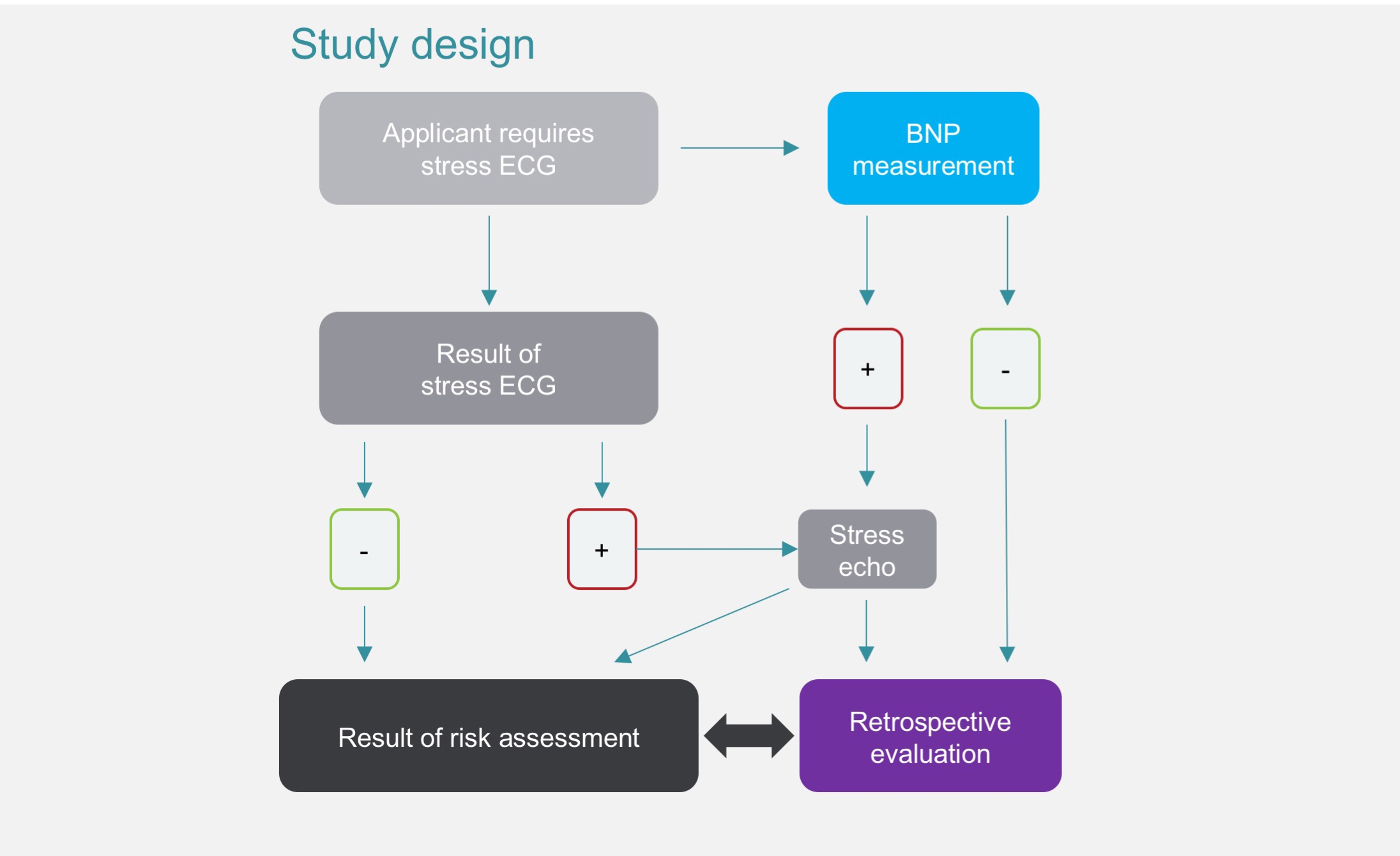
Status Quo
Biomarkers speed up application processes
Besides the stress ECG, there is another way of assessing existing or incipient heart disease. This involves determining the so-called NT-proBNP value as part of a blood count. The abbreviation stands for “N-terminal pro-brain natriuretic peptide”.
A high NT-proBNP concentration in the blood is a sign that heart disease is present. It can also provide information about the severity of the disease.
In the insurance context, the use of this biomarker has clear advantages. As the risk assessment for higher sums insured already involves an obligatory blood test, the NT‑proBNP value can be determined at the same time. A longer or additional doctor’s appointment to carry out a stress ECG is not necessary. Underwriters can make decisions themselves, based on the laboratory values presented, whereas they would need to get a doctor to assess the results of a stress ECG. Costs are reduced, as determining the NT-proBNP value costs, on average, only about half as much as a stress ECG.
For the stress ECG to be replaced with the NT-proBNP value, however, there would first need to be proof that both methods were equivalent. There had not previously been any comparative studies examining the effect of the NT-proBNP value and the stress ECG on the results of the risk assessment. In collaboration with nine life insurers, Munich Re therefore carried out its own study. The key question here was how the result of the risk assessment would have turned out if instead of the stress ECG only the NT-proBNP value had been available at the time of the application.

Focus on the advantages and disadvantages of the new method
As part of the study, both an NT-proBNP measurement and a stress ECG were carried out for 479 applicants. For the Munich Re study, the thresholds set for the NT-proBNP values were different from the standard clinical thresholds. This was necessary because, in everyday medical practice, the NT-proBNP value is normally only used to determine whether the cause of serious breathlessness is pulmonary or cardiac. For risk assessment, however, lower thresholds are set which are geared to normal values in groups of healthy individuals.
The evaluation of the study revealed that both methods lead to practically the same results in the risk assessment. In the study carried out with applicants for disability or life insurance, the NT-proBNP value [A1] was at least equivalent to the stress ECG. The study revealed the following advantages and disadvantages of the biomarker:
Advantages:
- Reduced costs: Determining the blood value is significantly cheaper than performing a stress ECG.
- Accelerated processes: The application process is reduced in two areas. First of all, the underwriter doesn’t have to wait for the stress ECG, and secondly he can assess the laboratory values himself. The faster processing leads to lower drop-out rates and ensures greater customer satisfaction.
- Greater acceptance: There are advantages for sales staff and customers alike. Sales staff no longer have to explain to their otherwise healthy customers why they need a stress ECG. Customers save time and effort and stress.
Disadvantages:
- Loss of information: The NT-proBNP value doesn’t give any information on blood pressure behaviour during physical exertion (stress hypertension).
- Anti-selection effect: A heart examination may already motivate the applicant to disclose any existing health problems in the application. This effect is smaller with a blood test, as the fact that “only” a blood value is required and not an ECG could encourage applicants not to disclose health conditions.
- Lack of experience: The NT-proBNP value has not yet been used in risk assessment. The thresholds for the risk assessment developed by Munich Re in its study would therefore have to be validated in practice over a longer period.
Conclusion: Suitability for applications without prior cardiac stress testing
Both the stress ECG and the NT-proBNP value lead to roughly the same number of abnormal results (2-3%), but with both methods – even after further clarification – no existing heart disease could be found. These are therefore so-called false-positive results. A risk loading was charged only in the rarest of cases, and in fact with both procedures (< 1%). For life insurers, screening for existing heart conditions in the application process is essential, as even where they have low prevalence, pre-existing conditions and anti-selection effects can lead to a disproportionate increase in claims payments.
The advantages listed make it clear that determining the NT-proBNP value for applicants with no known pre-existing cardiac disease constitutes a useful and cost‑effective alternative to the stress ECG. Munich Re has therefore included the laboratory value as a parameter in its web-based risk assessment system MIRA. There, as part of the risk assessment, users also find an evaluation of the special threshold values developed by Munich Re for the risk assessment. Where an applicant has a pre-existing heart condition, however, depending on the diagnosis, up-to-date examination findings should be requested (ultrasound, stress echocardiography, cardio CT/MRI etc.).
Expert

Related Topics
Newsletter
properties.trackTitle
properties.trackSubtitle

